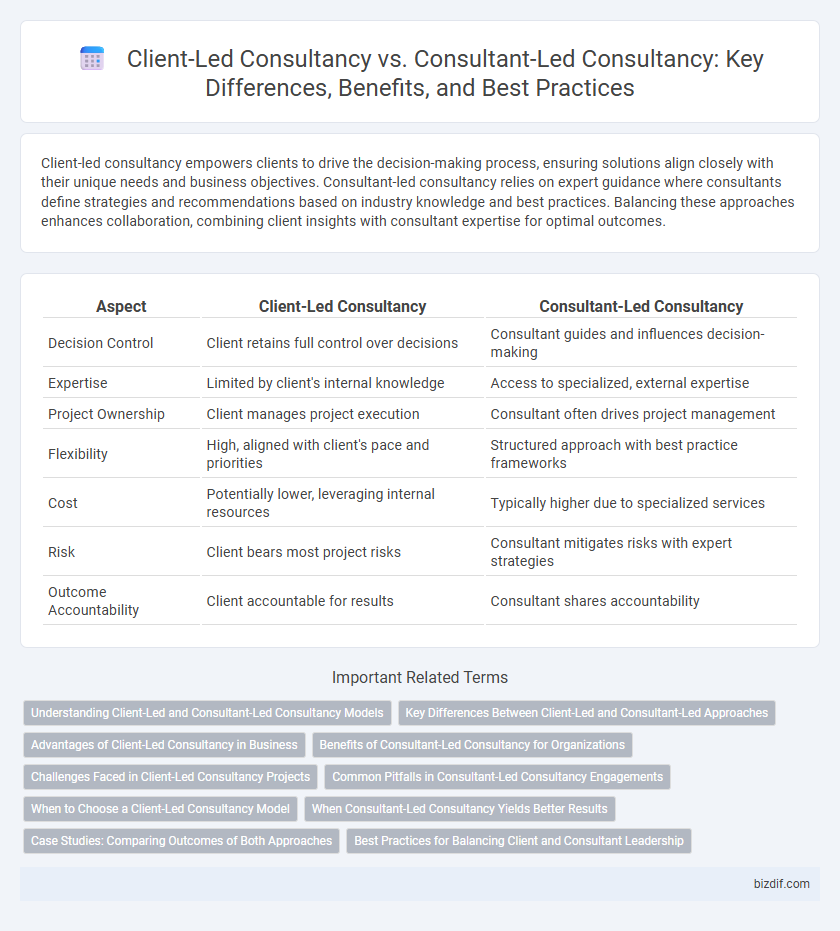Client-led consultancy empowers clients to drive the decision-making process, ensuring solutions align closely with their unique needs and business objectives. Consultant-led consultancy relies on expert guidance where consultants define strategies and recommendations based on industry knowledge and best practices. Balancing these approaches enhances collaboration, combining client insights with consultant expertise for optimal outcomes.
Table of Comparison
| Aspect | Client-Led Consultancy | Consultant-Led Consultancy |
|---|---|---|
| Decision Control | Client retains full control over decisions | Consultant guides and influences decision-making |
| Expertise | Limited by client's internal knowledge | Access to specialized, external expertise |
| Project Ownership | Client manages project execution | Consultant often drives project management |
| Flexibility | High, aligned with client's pace and priorities | Structured approach with best practice frameworks |
| Cost | Potentially lower, leveraging internal resources | Typically higher due to specialized services |
| Risk | Client bears most project risks | Consultant mitigates risks with expert strategies |
| Outcome Accountability | Client accountable for results | Consultant shares accountability |
Understanding Client-Led and Consultant-Led Consultancy Models
Client-led consultancy emphasizes active client participation, empowering organizations to steer project goals and decision-making processes, which enhances alignment with internal visions and increases ownership of outcomes. Consultant-led consultancy relies on expert consultants to drive strategy, diagnose issues, and propose tailored solutions, leveraging specialized knowledge and industry experience for efficient problem-solving. Understanding these models helps organizations select an approach that balances internal expertise with external insights to optimize project success and innovation.
Key Differences Between Client-Led and Consultant-Led Approaches
Client-led consultancy emphasizes the client's active involvement in decision-making and prioritizing internal insights, fostering tailored solutions aligned with organizational culture and goals. Consultant-led consultancy relies on the expert's specialized knowledge and methodologies to diagnose issues and prescribe strategies, often leading to faster implementation. Key differences include decision ownership, level of client collaboration, and flexibility in adapting processes to client needs.
Advantages of Client-Led Consultancy in Business
Client-led consultancy empowers businesses by prioritizing the client's unique insights and requirements, fostering tailored solutions that enhance relevance and impact. This approach promotes greater collaboration, resulting in improved alignment between strategic goals and operational execution. Businesses experience increased agility and ownership, accelerating implementation and driving sustainable growth.
Benefits of Consultant-Led Consultancy for Organizations
Consultant-led consultancy offers organizations expert-driven solutions tailored to complex challenges, leveraging industry best practices and advanced analytical tools for strategic decision-making. This approach accelerates problem-solving by combining consultants' specialized knowledge with objective assessments, resulting in more innovative and effective outcomes. Organizations benefit from reduced internal bias, enhanced efficiency, and access to cutting-edge methodologies that drive sustainable growth and competitive advantage.
Challenges Faced in Client-Led Consultancy Projects
Client-led consultancy projects often face challenges such as unclear project scopes due to limited consultancy expertise within the client organization, leading to misaligned expectations and delayed decision-making. Resource constraints and insufficient stakeholder engagement further complicate progress, causing inefficiencies and increased risk of project failure. Effective communication gaps between client teams and external consultants exacerbate difficulties in aligning goals and deliverables.
Common Pitfalls in Consultant-Led Consultancy Engagements
Consultant-led consultancy engagements often encounter pitfalls such as misaligned objectives due to insufficient client involvement, leading to solutions that lack practical applicability. Over-reliance on consultant expertise can result in reduced client ownership and resistance to change during implementation phases. Failure to integrate client insights early in the process frequently causes scope creep and project delays, diminishing overall engagement effectiveness.
When to Choose a Client-Led Consultancy Model
Choosing a client-led consultancy model is ideal when the client possesses clear industry expertise and strategic direction, allowing for active collaboration and decision-making. This model enhances agility and ensures that the consultancy's efforts align closely with the client's evolving business goals and internal knowledge. It is particularly effective in scenarios where the client demands transparency, control, and a partnership approach to problem-solving.
When Consultant-Led Consultancy Yields Better Results
Consultant-led consultancy yields better results when specialized expertise and objective external perspectives are critical for complex problem-solving and strategic decision-making. This approach drives innovation by leveraging consultants' extensive experience across industries, ensuring unbiased analysis and effective implementation of best practices. Organizations facing transformational change, regulatory compliance challenges, or entering new markets benefit most from consultant-led guidance, as it accelerates outcomes and mitigates risks.
Case Studies: Comparing Outcomes of Both Approaches
Case studies reveal that client-led consultancy often results in higher stakeholder engagement and tailored solutions aligned with company culture, enhancing implementation success rates by up to 25%. Consultant-led consultancy typically delivers faster problem identification and expert-driven strategies, increasing project efficiency and reducing time-to-insight by approximately 30%. Comparing both approaches highlights that blending client insights with consultant expertise optimizes decision-making and drives sustainable business outcomes.
Best Practices for Balancing Client and Consultant Leadership
Achieving optimal outcomes in client-led versus consultant-led consultancy requires clear communication of goals, roles, and expectations from the outset. Best practices emphasize collaborative decision-making frameworks that integrate client insights with consultant expertise to drive innovation and deliver tailored solutions. Continuous feedback loops and adaptive project management tools ensure alignment and agility throughout the consultancy engagement.
Client-led consultancy vs Consultant-led consultancy Infographic

 bizdif.com
bizdif.com